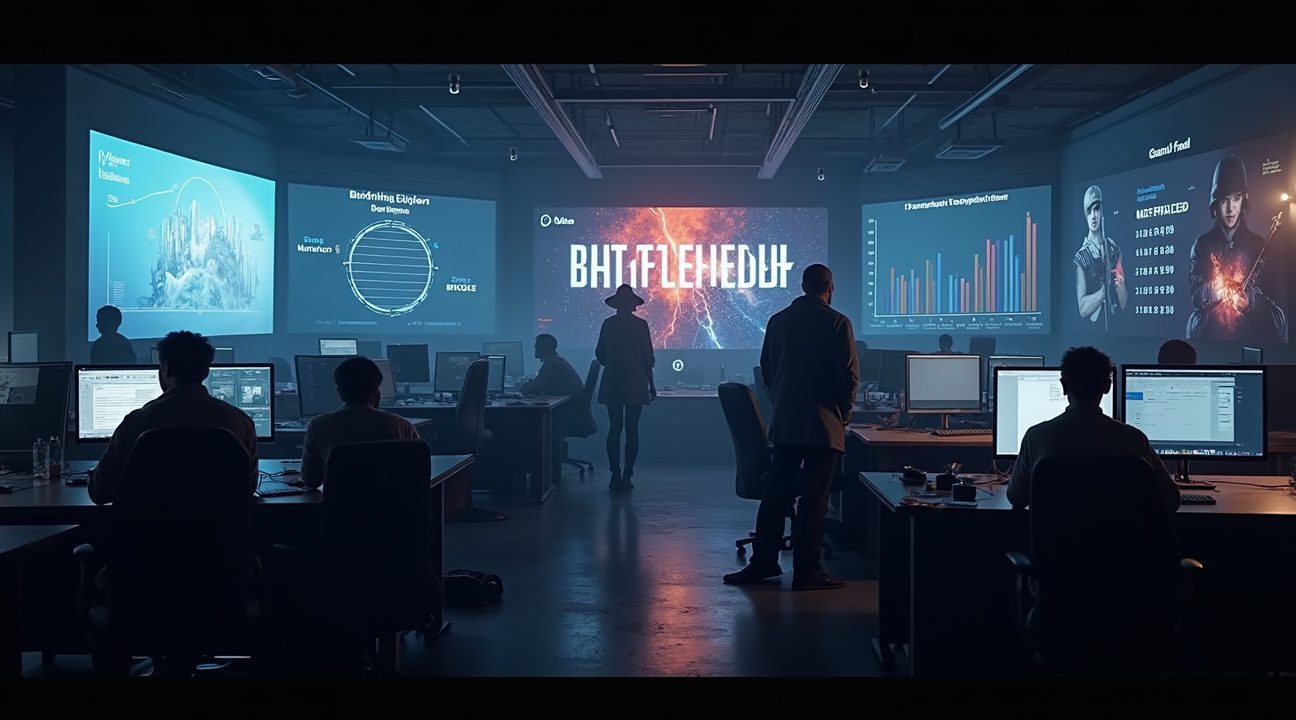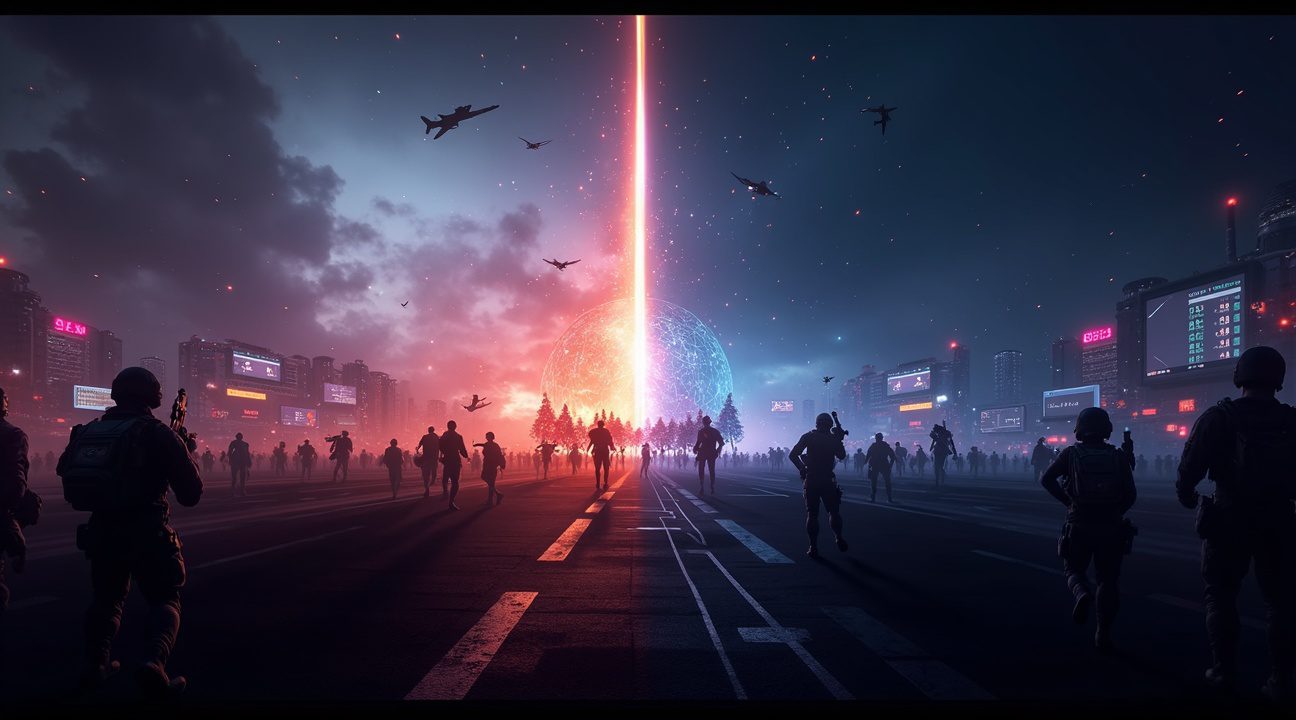EA has set an ambitious target of reaching 100 million players with “Battlefield 6,” a milestone that significantly surpasses the lifetime success of any previous entry in the franchise and has led to skepticism among developers and industry professionals.
Key Takeaways
- EA’s 100 million player goal is more than triple the franchise’s previous record of 30 million players, leading to substantial doubt internally about whether it’s a realistic benchmark.
- Development costs have exceeded $400 million due to production challenges involving multiple game studios, frequent delays, and the need to redo core components of the game.
- The launch saw over 7 million copies sold within the first three days and peaked at 747,440 concurrent players on Steam, but approximately 70% of those players dropped off within weeks, highlighting major retention issues.
- EA is banking on a standalone free-to-play battle royale mode to mirror the success of titles like Call of Duty: Warzone, removing cost barriers and potentially helping to reach the 100 million-player milestone.
- An aggressive influencer-focused campaign has been launched, which includes flying content creators to exclusive events in Los Angeles, acknowledging that traditional ads may not be sufficient to capture such a massive audience in today’s competitive market.
To learn more about EA’s overall strategy and the challenges ahead for “Battlefield 6”, readers can explore this official EA Battlefield page for further updates and announcements.
Developers Question Whether 100 Million Player Goal is Even Possible
EA’s internal target of 100 million players for Battlefield 6 has sparked considerable debate among developers who question whether such ambitious numbers are achievable. The goal encompasses players from launch through an extended post-launch period, but industry insiders express serious doubts about the feasibility of this massive player acquisition strategy.
Historical Performance Creates Skeptical Foundation
The franchise’s track record provides context for why developers harbor concerns about EA’s expectations. The most successful Battlefield title in the series’ history reached just over 30 million players throughout its complete lifecycle. This established benchmark means EA expects Battlefield 6 to attract more than triple the player count of any previous entry in the franchise.
DICE developers reportedly don’t believe the 100 million player goal is realistic, creating internal tension about the direction of the project. Their skepticism stems from practical experience with the franchise’s performance patterns and understanding of market dynamics. Previous Battlefield releases have demonstrated consistent player engagement within certain ranges, making the quantum leap to 100 million appear increasingly challenging.
The ambitious target has fundamentally shaped the entire development strategy, forcing teams to reconsider traditional approaches to game design, marketing, and player retention. Developers must now balance creative vision with commercial imperatives that may push the game in directions that don’t align with core franchise strengths.
Market Realities Challenge Ambitious Expectations
Critics argue that EA’s expectations may be disconnected from market realities and competitive pressures. The gaming landscape has become increasingly saturated with Call of Duty Modern Warfare 3 continuing to dominate the military shooter space, while other franchises compete for player attention.
External skepticism mirrors internal concerns about whether such massive player acquisition is possible without fundamentally changing what makes Battlefield unique. The pressure to reach 100 million players could lead to design decisions that prioritize broad appeal over the tactical gameplay that has defined the series. Industry observers note that few games outside of free-to-play mobile titles or established franchises like Fortnite have achieved such massive player counts.
The challenge becomes even more complex considering that EA has made strategic decisions regarding other franchise properties that could impact resource allocation and focus. Competition within EA’s own portfolio creates additional hurdles for achieving unprecedented success with Battlefield 6.
Mass player acquisition at this scale requires not just an exceptional game but also:
- Perfect timing
- Strategic marketing execution
- Favorable market conditions
The gaming industry has seen numerous high-profile releases fail to meet ambitious player targets, despite significant investment and development resources.
EA’s strategy reflects broader industry trends where publishers set increasingly ambitious goals to justify massive development budgets and investor expectations. However, the gap between historical performance and projected success for Battlefield 6 represents one of the largest leaps in expectations for any major franchise release.
The developer skepticism signals potential challenges ahead as teams work to balance creative integrity with commercial pressures. Whether EA’s ambitious vision can overcome both internal doubts and market realities remains the central question as Battlefield 6 development continues.

Strong Launch Numbers Reveal Troubling Player Retention Trends
EA’s Battlefield 6 achieved remarkable launch metrics that demonstrated significant initial market enthusiasm. The game reached an impressive all-time peak of 747,440 concurrent players on Steam during its October 10, 2025 launch day, establishing it as one of the platform’s most anticipated releases. Sales performance matched this momentum, with over 7 million copies sold within the first three days across all platforms.
I observed that these figures represent a substantial improvement over previous Battlefield entries’ launch performance. The game had already shown promise during its open beta phase on August 9, 2025, when concurrent players peaked at 521,079, suggesting strong pre-launch anticipation. Total ownership estimates across all platforms now range between 7.07 million and 9.63 million players, indicating healthy multi-platform adoption.
Concerning Decline in Player Engagement
Despite these encouraging launch statistics, troubling patterns emerged within weeks of release. By November 26, 2025, Steam’s active player count had fallen dramatically to approximately 149,585, with the 24-hour peak reaching only 216,661 players. This represents a significant decline from the launch day highs, raising questions about long-term player engagement and content satisfaction.
The retention challenges become more apparent when examining the data trajectory. From the launch peak of 747,440 concurrent players to the November figures, I can see roughly a 70% drop in active Steam users. This pattern suggests that while Battlefield 6 successfully attracted initial interest, maintaining player engagement proved more challenging. Such retention issues could impact EA’s ambitious goal of reaching 100 million total players, especially given the competitive landscape with titles like Call of Duty Modern Warfare 3 and concerns about EA’s commitment to certain franchises.
The multi-platform availability hasn’t fully compensated for these retention challenges on Steam, which often serves as a key indicator for PC gaming trends. While console and other platform data remains less transparent, the Steam metrics provide valuable insights into player behavior patterns that could extend across the entire player base.

Development Budget Balloons Past $400 Million Amid Production Chaos
EA’s ambitious pursuit of 100 million players for Battlefield 6 has come with a staggering financial cost, as development expenses have skyrocketed past the $400 million mark. This astronomical budget reflects the publisher’s determination to create a franchise-defining entry, yet the spending hasn’t translated into smooth production progress.
Production timelines have suffered significant setbacks, with the multiplayer component remaining the only major element that hadn’t reached alpha status by spring 2025. This delay represents more than a year behind the original development schedule, creating mounting pressure on EA’s already stretched resources. The company’s multi-studio approach, while intended to accelerate development, has instead generated coordination nightmares that have plagued the project from its early stages.
Multi-Studio Chaos Forces Development Restarts
EA’s decision to distribute Battlefield 6’s development across multiple internal studios has created communication breakdowns and conflicting design philosophies. Several teams have been forced to abandon months of work and restart entire components from the ground up, contributing directly to the ballooning budget. These coordination failures have necessitated intervention from other internal teams, further straining EA’s development resources and extending production timelines.
The scale of these issues becomes more apparent when considering that major gameplay features remained undecided even as the project moved into alpha testing phases. This lack of clear direction has resulted in wasted development cycles and redundant work across different studios, explaining much of the excessive spending that has pushed the budget well beyond initial projections.
EA’s investment strategy for Battlefield 6 raises serious questions about the sustainability of such massive development budgets in today’s gaming landscape. While GTA sales records demonstrate that blockbuster titles can justify enormous investments, the disorganized nature of Battlefield 6’s production suggests poor resource allocation rather than strategic spending.
The publisher’s approach contrasts sharply with competitors who have achieved success through more focused development strategies. Call of Duty’s recent releases have maintained consistent quality while operating with more streamlined production processes, highlighting potential inefficiencies in EA’s current methodology.
These development troubles occur as EA faces broader challenges across its portfolio, with Battlefield and Apex Legends facing uncertainties about their future. The company’s massive financial commitment to Battlefield 6 represents a significant gamble on the franchise’s ability to compete with established rivals and justify the extraordinary development costs that continue to escalate.

Free-to-Play Battle Royale Mode Could Be Key to Reaching Player Target
I believe EA’s ambitious 100 million player target for Battlefield 6 hinges on one crucial strategy: a standalone free-to-play battle royale mode. This approach would mirror the successful model established by Call of Duty: Warzone, which separated its battle royale experience from the main franchise entries.
EA already possesses a proven blueprint for this strategy through Respawn Entertainment’s Apex Legends, their standout free-to-play success that launched in 2019. The game demonstrated how removing financial barriers can dramatically expand a player base beyond what traditional premium pricing allows. This precedent gives EA confidence that a similar approach could work for the Battlefield franchise.
Why Traditional Pricing Won’t Achieve the Goal
Current industry dynamics make it virtually impossible for a standard $70 or $80 game to reach 100 million players, regardless of quality or marketing budget. Even the most successful AAA releases struggle to breach those numbers when locked behind premium pricing. The only exception appears to be highly anticipated titles like Grand Theft Auto 6, which benefit from unprecedented cultural momentum and brand recognition.
Battlefield 6 plans to deliver both a comprehensive single-player campaign and full multiplayer suite as part of its core offering. However, analysts consistently point to the separate free-to-play battle royale component as the primary vehicle for achieving EA’s lofty player count objectives.
This monetization strategy removes the biggest barrier to entry—upfront cost—while creating multiple revenue streams through cosmetics, battle passes, and premium content. Players can experience the Battlefield universe without financial commitment, potentially converting them into paying customers over time through engaging gameplay and compelling post-launch content.
The success of this approach depends heavily on execution and timing. EA has witnessed firsthand how competitive pressures can impact player engagement across their portfolio. A well-designed, standalone battle royale mode could capture market share from existing competitors while introducing new audiences to the Battlefield franchise’s signature large-scale warfare and destructible environments.
Free-to-play accessibility combined with Battlefield’s unique gameplay mechanics creates a compelling proposition for both casual and hardcore players. This strategy represents EA’s best chance to transform an ambitious internal target into achievable reality through smart market positioning and player-friendly pricing structures.

All-Out Marketing Blitz Includes Flying Influencers to Los Angeles Events
EA’s marketing strategy for Battlefield 6 represents one of the most aggressive promotional campaigns I’ve witnessed in recent gaming history. The publisher recognizes that achieving 100 million players requires far more than traditional advertising methods, so they’re investing heavily in influencer-driven content creation and experiential marketing events.
Star-Studded Los Angeles Launch Events
Content creators and gaming influencers are receiving all-expenses-paid invitations to exclusive reveal events in Los Angeles. These carefully orchestrated gatherings provide hands-on access to Battlefield 6, allowing influencers to capture authentic gameplay footage and reactions that feel genuine to their audiences. EA’s strategy leverages the trust these creators have built with their communities, understanding that personal recommendations carry more weight than corporate advertisements.
The company has reportedly allocated substantial budgets for these promotional initiatives, flying in top-tier content creators from around the globe. These events generate immediate social media buzz while creating a pipeline of authentic content that extends far beyond the initial reveal period. Each influencer brings their unique audience, multiplying EA’s reach across diverse gaming communities.
Beta Coverage and Sustained Promotional Campaigns
EA’s marketing efforts extend well beyond launch events, with comprehensive coverage planned for Battlefield 6’s open beta period. The publisher has established partnerships with major gaming influencers who will document their beta experiences, providing ongoing content that maintains momentum between the initial reveal and full release.
Paid campaigns complement these organic partnerships, ensuring maximum visibility across multiple platforms and demographics. This multi-pronged approach addresses different audience segments while maintaining consistent messaging about the game’s ambitious scope and features. The sustained promotional timeline helps build anticipation while gathering valuable feedback from both creators and their communities.
These marketing investments reflect EA’s understanding that modern game launches require community-driven promotion rather than top-down advertising. By empowering content creators with early access and premium experiences, the publisher creates authentic advocacy that resonates with potential players. The significant financial commitment demonstrates EA’s confidence in Battlefield 6’s potential while acknowledging the competitive landscape requires exceptional promotional efforts.
The strategy mirrors successful launches from other major publishers, though EA’s scale and ambition appear unprecedented for the Battlefield franchise. This comprehensive approach positions Battlefield 6 to compete effectively against established titles like Call of Duty Modern Warfare 3 while building the massive player base necessary to achieve their 100 million player target.

Industry Context Shows Just How Unrealistic EA’s Player Expectations Really Are
The gaming industry provides stark context for EA’s ambitious 100 million player target when I examine actual performance metrics across major franchises. Call of Duty Modern Warfare 3 and the entire franchise combined reached approximately 20.6 million players in 2025—a figure that highlights the astronomical gap between EA’s expectations and market reality.
Market Dynamics Paint a Challenging Picture
The current AAA market dynamics present significant obstacles that make EA’s target appear disconnected from industry trends. Studios are experiencing widespread layoffs and closures, creating an environment where even established franchises struggle to maintain consistent player bases. EA’s recent decisions regarding Battlefield and Apex Legends demonstrate the company’s willingness to restructure properties when they don’t meet internal expectations.
Battlefield 6’s return to modern-day settings after more than a decade represents a calculated attempt to reclaim mainstream appeal, yet this strategy carries inherent risks. The competitive landscape has evolved dramatically since Battlefield’s last modern entry, with established players dominating market share and new entrants struggling to gain traction.
Internal Pressure Creates Design Compromises
Industry insiders warn that EA’s 100 million player target is directing the game’s entire development trajectory in potentially harmful ways. This pressure often results in safe, revenue-focused design choices that prioritize broad appeal over creative innovation. Game design philosophy suffers when developers must balance artistic vision with unrealistic commercial demands.
The consequences extend beyond creative limitations. Development burnout becomes increasingly likely when teams work under the weight of impossible expectations. EA’s other gaming ventures show how internal pressure can reshape projects fundamentally, sometimes compromising their original identity.
Missing this internal goal could jeopardize EA’s commercial standing and influence future Battlefield decisions. The company’s track record suggests they’re willing to make dramatic changes when projects don’t align with expectations, as evidenced by their approach to other major franchises. Even successful properties like GTA’s record-breaking sales demonstrate that sustained success requires realistic goal-setting rather than aspirational targets that ignore market constraints.
The volatile nature of today’s gaming market means that even well-funded AAA projects face uncertain futures, making EA’s 100 million player expectation appear increasingly disconnected from achievable industry benchmarks.

Sources:
EA – Developers Question Whether 100 Million Player Goal is Even Possible
EA – Strong Launch Numbers Reveal Troubling Player Retention Trends
EA – Development Budget Balloons Past $400 Million Amid Production Chaos
EA – Free-to-Play Battle Royale Mode Could Be Key to Reaching Player Target
EA – All-Out Marketing Blitz Includes Flying Influencers to Los Angeles Events
EA – Industry Context Shows Just How Unrealistic EA’s Player Expectations Really Are


